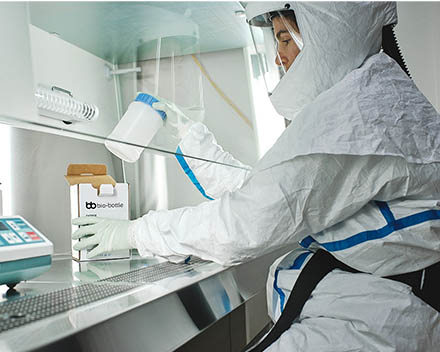
“The University’s successful efforts to attract national research funds show that we’re on the right track.”
Executive Board
Extraordinary achievements
Not only did the lockdown limit research activities, it also kicked off a valuable learning process. Bern’s scientists were also highly active, particularly with respect to research into COVID-19 and ways to combat it.
By Prof. Dr. Daniel Candinas, Vice-Rector for Research
The extraordinary situation surrounding the coronavirus pandemic also left its mark on the University’s research operations in many ways over the past year and went hand in hand with a learning process that yielded valuable information about how the University works as a whole. Now that I’ve been able to look at the events of the past months from a more detached vantage point and venture a cautious look ahead, I can honestly say that we might have slightly underestimated the high degree of personal responsibility, self-organization and improvisational talent of the researchers at this extremely diverse, research-intensive university.
Did you know?
"With Interfaculty Research Cooperations (IRCs), which unite 8 to 13 research groups from various faculties, the University of Bern specifically promotes interdisciplinary research. The three IRCs on sleep, religious conflict and the health of the environment, plants, humans and animals were extended in 2020 because of their impressive track record."
Research in emergency operations mode
There was a great deal of uncertainty when the nationwide lockdown was declared in March 2020, particularly in light of the fact that reliable information was scarce and given the enormous sense of apprehension and dismay triggered by images of army trucks transporting bodies at night in Lombardy. During that phase, the University Executive Board decreed several measures aimed primarily at ensuring staff safety and safeguarding our infrastructures. In the area of research, the main objective of this emergency operations mode was to ensure that essential research activities requiring an on-site, physical presence could continue. This mainly concerned experiments involving substances, plants and animals as well as ongoing experiments that could not be interrupted without serious consequences. This exception applied to research on and to combat COVID-19, in particular.
While this emergency operations mode was in effect, nearly 250 requests were processed for experiments to be continued under these special conditions, with around 200 of these eventually receiving approval (although subject to various restrictions). While it was somewhat easier for students and staff from the faculties of theoretical science, the humanities and social sciences to continue their work from home, this transition still had considerable repercussions on their work. Even though “square eye syndrome” became an unaccustomed yet frequent complaint expressed by some of the people affiliated with the University as restrictions were first relaxed towards the summer, it was still amazing to see how digital communications had swiftly reached a fairly high level of acceptance on the various channels and how research operations could be shifted slightly and resumed. In this context, however, we also saw where the weak points were and how challenging it was for our occasionally outdated infrastructures to facilitate efficient collaboration under difficult conditions.
The other phases we experienced during the pandemic year were a bit of a “phony war” that came in waves. Responsibility for precautions that had initially been imposed centrally was gradually handed back over to
the various faculties and institutes. Two factors remained important: the implementation of the adapted protection concepts and that information about critical events be made available in a timely manner in every area of research operations. In this respect, the emergency operations phase activated several communication channels that have become indispensable and are helping us to approach individual issues in a more differentiated way than was initially possible.
Promotion of interdisciplinarity pays off
While preparing this report, I noticed just how active and successful Bernese researchers were during this special pandemic year, even despite the more difficult conditions. On that note, I’d like to call special attention to the approximately 200 SNSF project applications and over 40 newly funded EU projects. One particularly positive bit of news is that many early career researchers were successful with their applications, as well.
Finally, I’d like to shift my attention back to the coronavirus: The Swiss National Science Foundation launched two COVID-19 research programs in which the University of Bern was extremely successful. In its “Special call for research on coronaviruses”, eight Bernese projects (from 36 submitted nationwide) received funding worth a total of CHF 2.4 million (of CHF 10 million distributed throughout Switzerland). Seven projects from Bern were selected to receive CHF 6 million (27 projects nationwide received CHF 20 million in funding) within the scope of National Research Fund 78 on “COVID-19”. Several different factors gave our Bern campus an edge: We have highly qualified researchers, we prioritize methodical excellence in the basic subjects and we have been fostering an interdisciplinary approach for several years now. Building on that foundation, we were able to quickly and flexibly create new working groups with innovative approaches ranging from basic research to clinical translation to psychological, social and economic issues. They cover a broad range of topics – from issues in the area of pulmonology to topics related to epidemiology and social science. It’s also important to note that the funded projects involve international networks that include researchers from Oxford, Yale and Tokyo. The University’s successful efforts to attract national research funds show that we’re on the right track.
